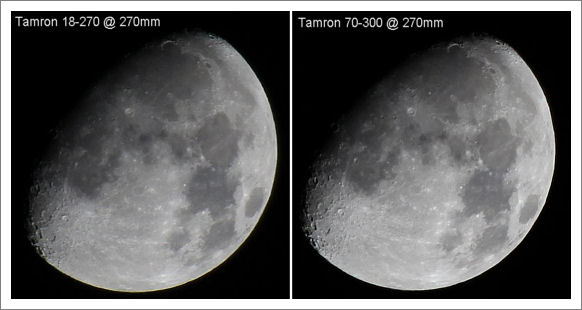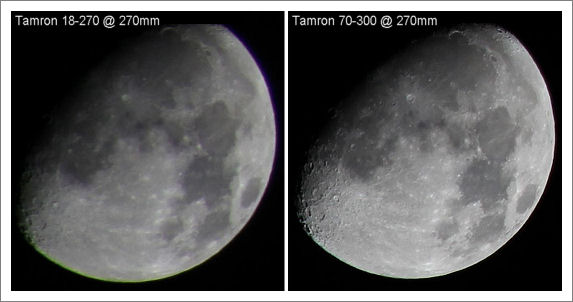

Tamron 18-270/3.5-6.3 DiII VC PZD lens review
Optical Performance
Distortion

Left: shot of rectangular poster @ 18mm. Right: "Normal" scene at 18mm
As might be expected from a wide range zoom of this type, there is distortion. It's most noticeable at the 18mm setting where I measured it at around 4% (barrel). On "normal" shots you might not see it, but if you are filling the frame with a rectangular object you certainly will. Luckily distortion can be fairly easily corrected (or at least minimized) in most image editors.
As the lens is zoomed out distortion drops and is least noticeable around the 35mm setting. As the lens is zoomed out further pincushion distortion appears, reaching about 2.3% at 100mm and falling slightly to around 1.7% at 270mm.
Chromatic Aberration
As with distortion, chromatic aberration is most noticeable at the focal length extremes. It's strongest in the corners of the image at the 18mm and 270mm settings. At around 50mm chromatic aberration is negligible. Some of the examples below illustrate the extent of chromatic aberration at the corners of the image.
Vignetting
The Tamron 18-270/3.5-6.3 DiII VC PZD vignettes as you'd expect from a lens of this type, though vignetting is reasonably well controlled. Wide open, 18mm the corners are about 1.5 stops darker than the center. At 50mm vignetting is least and wide open the corners are only about 0.5 stops darker than the center. Vignetting increases as the lens is zoomed out and wide open at 270mm I measured the corners as about 1.25 stops darker than the center.
Stopping down does reduce vignetting somewhat, especially at the telephoto end of the range, but at 18mm there was still about 2/3 stop vignetting even with the lens stopped down to f11. Vignetting is also fairly easy to correct digitally in most image editors. The rightmost image of the composite image shown above was taken at 18mm and f6.3. You can see that the sky is darker in the upper corners of the image, but the effect isn't so strong as to appear unnatural.
Image Sharpness
At all focal lengths, the image quality in the center of the frame is good, but at the focal length extremes there is noticeable softening in the corners of the image which even stopping down won't do much to reduce.

50% crops from images of the moon in the center of the frame (EOS 60D). Both lenses set to f6.3
The images above show the sharpness in the center of the image. Both are good (though the 70-300 VC is slightly better. However the story changes when we look in the corners of the frame:

50% crops from images of the moon in the corner of the frame (EOS 60D). Both lenses set to f6.3
In the corner of the frame the Tamron 18-270/3.5-6.3 DiII VC PZD image is soft and shows chromatic aberration. Stopping down doesn't really help much.
Moving to the other end of the focal length range, 18mm, we see similar behavior. This time the comparison is with the Canon 17-85/3.5-5.6 IS USM.
.jpg)
As you can see, the center image quality is pretty similar. Both are quite good. However looking in the corners of the image the EF-S 17-85 becomes softer and shows chromatic aberration, but the Tamron 18-270 is even softer and shows similar chromatic aberration. Stopping down helps a bit but no amount of stopping down will make the corners sharp with either lens, nor will it lower chromatic aberration.

Image quality at 76mm is good, with low distortion, low chromatic aberration and good sharpness from center to corner.
Image quality in the corners improves as the lens is zoomed out to 50mm. At 50mm there is still some slight softening of the corners but it's much less than is seen at 18mm and chromatic aberration is also much lower. In the mid range, around 100mm, the Tamron 18-270/3.5-6.3 DiII VC PZD shows good center and edge sharpness with very little visible chromatic aberration. As the lens is zoomed out further the corners soften up again and chromatic aberration returns.
NEXT:-> Conclusions
